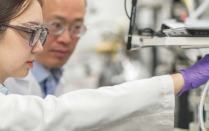Tanks of Algae May Herald Future of Carbon Capture Tech

Three tanks that act as photobioreactors hold microalgae grown by Helios-NRG in the Dorsheimer Greenhouse on the North Campus. The company is developing technology for capturing carbon dioxide using algae. Photo: Douglas Levere
Helios-NRG and Haiqing Lin Group Develop Carbon Capture Tech
Haiqing Lin, associate professor of chemical and biological engineering, School of Engineering and Applied Sciences, is helping Helios-NRG develop efficient, long-lasting membranes for inexpensively separating algae and water.
Overview
The ultimate goal of this project is to reduce pollution and fight climate change. To do this, biotech startup Helios-NRG is testing technologies for algae cultivation and carbon capture in a greenhouse on the North Campus.
Algae, mostly residing in aquatic habitats, have an ability to consume carbon dioxide to perform photosynthesis. If grown in dense enough concentrations, these organisms could presumably be used to capture carbon dioxide from power plants that burn coal or natural gas. In one project, Haiqing Lin, associate professor of chemical and biological engineering, School of Engineering and Applied Sciences, is helping Helios-NRG develop efficient, long-lasting membranes for inexpensively separating the algae and water.
“Fossil fuel power plants are dominant sources of carbon dioxide production,” says Ravi Prasad, president of Helios-NRG. “This is a global problem with severe effects, and more and more people are realizing that we need to do something about it. By developing a sustainable biotechnology approach for carbon capture, our company is working to address the challenge of climate change.”

Harvested algae can be used in products such as biofuel, animal feed and nutraceuticals. To dewater the algae, Helios-NRG first produces a concentrated algae slurry, as pictured. Photo: Douglas Levere

A sample of Helios-NRG’s dried, powdered algae biomass. This material has been refined through the company’s specialized process. The dried biomass is a precursor to products such as biofuel, animal feed and nutraceuticals. Photo: Douglas Levere


